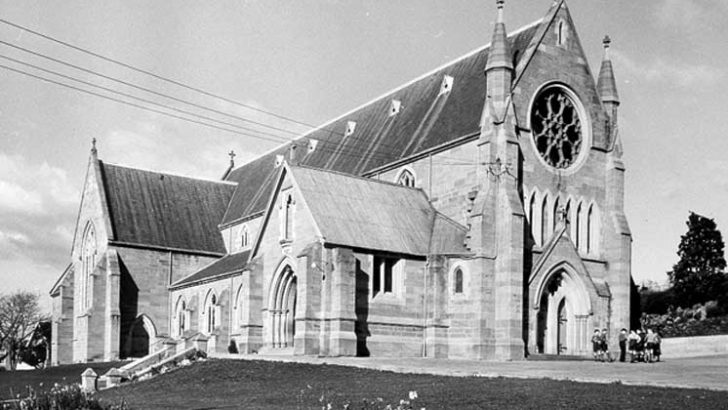Felix M. Larkin
There are many connections between Ireland and Tasmania, and not only because of the latter’s status as a penal colony in the first half of the 19th Century.
These connections are reflected in a beautiful stained glass window in St Mary’s Catholic Cathedral in Hobart.
Erected in 1995, the window is dedicated to “women whose saintly and heroic lives brought grace and life to God’s people”.
Included in the window are three Irishwomen: Nano Nagle (1718-1784), founder of the Presentation Sisters; Catherine McAuley (1778-1841), founder of the Sisters of Mercy; and Mary Aikenhead (1787-1858), founder of the Religious Sisters of Charity. All three of these orders of nuns have had a presence in the history of Tasmania.
Excommunicated
Only one of the women in the window was Australian. St Mary MacKillop (1842-1909) is the sole Australian-born saint to date. Canonised in 2010 (15 years after the window was made), she was the founder of the Josephite Sisters and has the distinction of having been excommunicated in 1871 for insubordination to the bishop in Adelaide where she was based. An episcopal commission later exonerated her, and the excommunication was lifted.
Two other founders of religious orders of nuns are celebrated in the window – one French, the other English. St Mary Euphrasia Pelletier (1796-1868) founded the Sisters of the Good Shepherd and Mary Potter (1847-1913) was the founder of the Little Company of Mary.
Pole position
Two Doctors of the Church, St Catherine of Siena (1347-1380) and St Teresa of Ávila (1515-1582), also feature in the window – as does St Monica, the mother of St Augustine of Hippo.
In pole position on the window, at the top left-hand corner, is Martha – the sister of Mary and Lazarus. She is shown holding a bunch of keys, symbolising her domesticity. She is the mistress of the household. A feminist interpretation of this iconography, however, sets her up as the female counterpart of St Peter, keys being associated with him also. Both are thus seen as progenitors of the Christian church.
This feminist reading is given added weight here by the fact that Martha is the first of 12 subjects depicted in the window, paralleling the 12 apostles.
Martha and Monica are two of four women honoured in the window who were not members of religious orders. The other two are St Margaret Clitherow (1556-1586) and Caroline Chisholm (1808-1877). Clitherow was an English Reformation martyr, sometimes known as the ‘Pearl of York’.
She suffered a most gruesome execution by being crushed to death. Her crime was that of harbouring priests, and she was pregnant with her fourth child at the time of her execution.
Mrs Chisholm, another Englishwoman, lived in Australia for many years and is remembered for her selfless support of female immigrants to Australia who, often penniless on arrival, were in danger of falling into a life of crime and prostitution. Her work with Irish female emigrants is noted in the exhibition ‘Cobh, the Queenstown story’ at the Cobh Heritage Centre in Co. Cork.
Caroline Chisholm would eventually have a family connection with Ireland. Her daughter and namesake married Edmund Dwyer Gray, owner of Dublin’s Freeman’s Journal newspaper and an Irish nationalist MP at Westminster.
Their son, also Edmund Dwyer Gray, went to Australia after his family lost control of the Freeman in the early 1890s. He settled in Tasmania and was a prominent journalist and politician there. He was premier of Tasmania for a short time in 1939, and died in Hobart in 1945.
The exterior of Hobart cathedral contains further evidence of Ireland’s connections with Tasmania.
Over the main entrance to the cathedral is a tablet commemorating Daniel Murphy, the second bishop and the first archbishop of Hobart. He was a native of Co. Cork and had been educated in Maynooth.


 St. Mary's Cathedral
St. Mary's Cathedral 